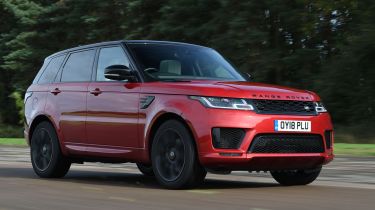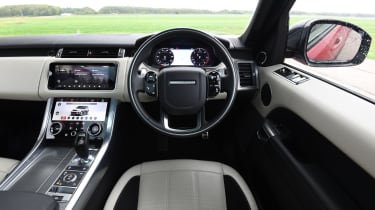Range Rover Sport (2013-2022) review - Interior, design and technology
A wonderful interior, more than worthy of the Range Rover badge, that's packed with technology - although it's not quite latest-generation stuff

The Range Rover Sport’s interior leaves you in no doubt it’s a genuine luxury vehicle. Even in standard HSE guise, there are swathes of posh Oxford leather, jewel-like switchgear and a central widescreen monitor.
It’s a more sporting layout than the formal and upright Range Rover – and, for this version, bespoke to the Sport (the previous model had an interior shared with the Land Rover Discovery). It’s like a posher, more grown up Range Rover Evoque, and feels great to sit inside. Even the steering wheel is a treat to hold and look at.
Our one gripe is that, for all this luxury, the technology isn’t as up to date as it could be. The minor switchgear will be very familiar to other Land Rover drivers and even the column stalks are from the JLR parts bin.
But lavish design makes up for it. You can fully customise the premium Range Rover Sport, too, with even plusher leather options and a wide array of trim strip decors. Also available is a head-up display that shows info such as speed, gear position, cruise control information, traffic sign recognition and sat nav directions.
The regular HSE probably contains all you’ll ever need as standard: sat-nav, xenon headlights, Oxford leather, heated front seats, front and rear parking sensors, an electric tailgate and Adaptive Dynamics suspension. 20-inch alloys are standard, too.
Our choice is the HSE Dynamic, though. This adds 21-inch alloys, carbon fibre interior trim and gloss black exterior styling highlights, for an even more sporting and distinctive look (we also like the twin exhausts). Terrain Response 2 and All-Terrain Progress Control are also standard.
Used - available now

2022 Land Rover
Range Rover Sport
37,680 milesAutomaticDiesel3.0L
Cash £36,495
2020 Land Rover
Range Rover Sport
69,150 milesAutomaticDiesel3.0L
Cash £29,995
2022 Land Rover
Range Rover Sport
51,660 milesAutomaticPetrol2.0L
Cash £34,495
2022 Land Rover
Range Rover Sport
46,978 milesAutomaticPetrol2.0L
Cash £34,787The most indulgent model is the Autobiography Dynamic, which has a panoramic glass roof, gloss black exterior styling embellishments, semi-Aniline leather 22-way adjustable climate front seats and a front centre console cooler. The SVR, meanwhile, lives up to its range-topping position with a whole host of technology, luxury and performance upgrades.
Sat-nav, stereo and infotainment
The Touch Pro Duo system is common across the Land Rover line-up, although if you include the digital dials, then you could argue that the Range Rover Sport has a three-screen set-up. The Sport’s screens are split logically, with climate controls and Terrain Response settings on the bottom screen, navigation, audio and phone functions on the display above.
The two rotary dials that are part of the lower screen are useful, because they can be used to quickly adjust the temperature of the dual-zone climate control, while pressing them brings up settings for the heated seats. Unfortunately, the screens themselves can be a little unresponsive at times.
The digital instrument cluster can be set up to show sat-nav maps and directions, or other driving and media info via the touch-sensitive buttons on the steering wheel. It takes a bit of time to get used to the controls, but is a useful feature once you’re familiar.








